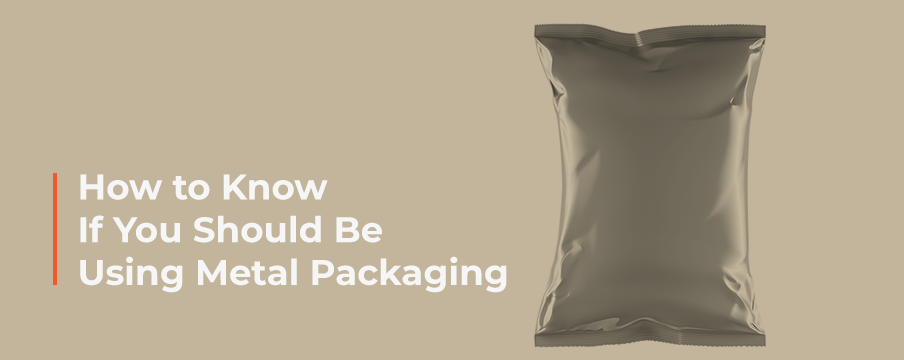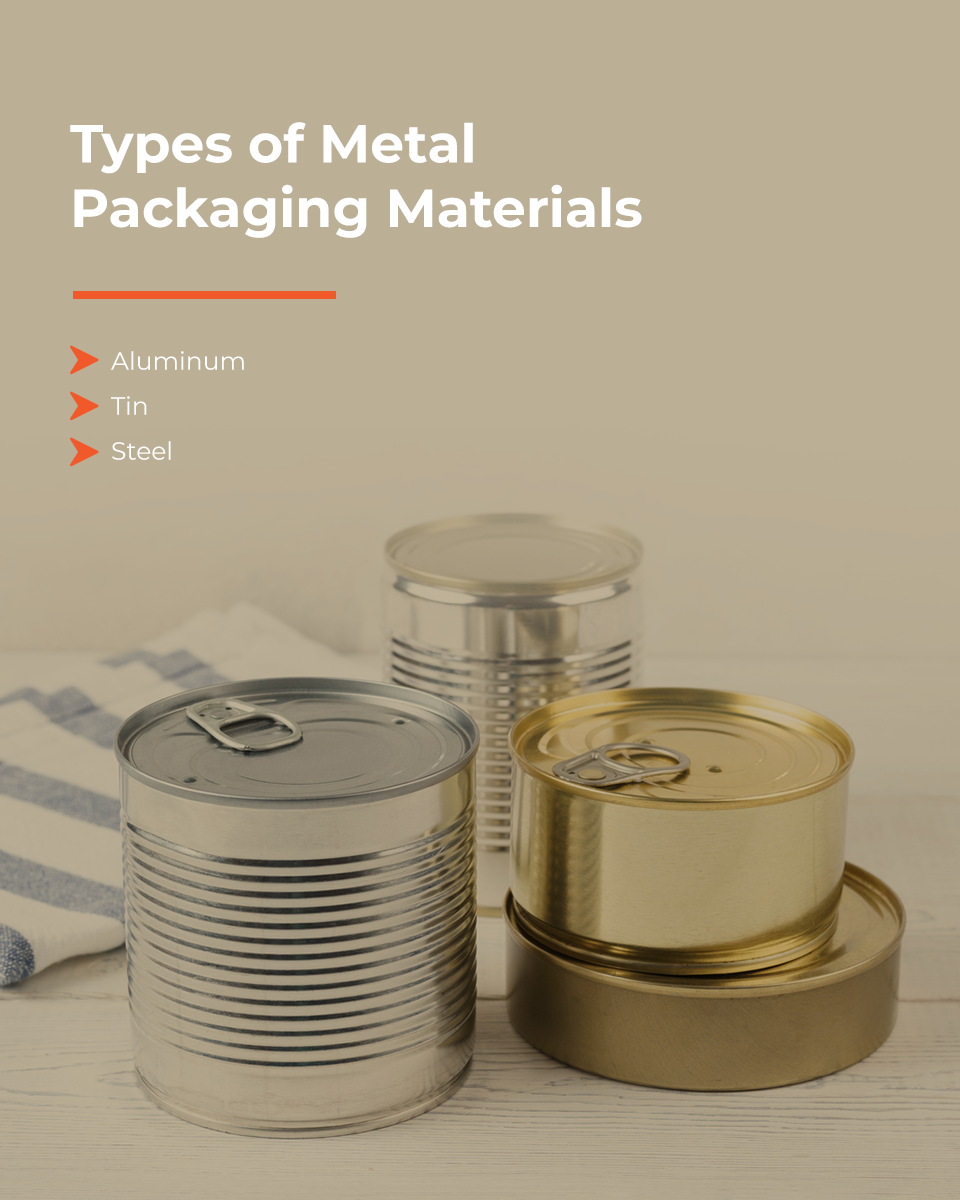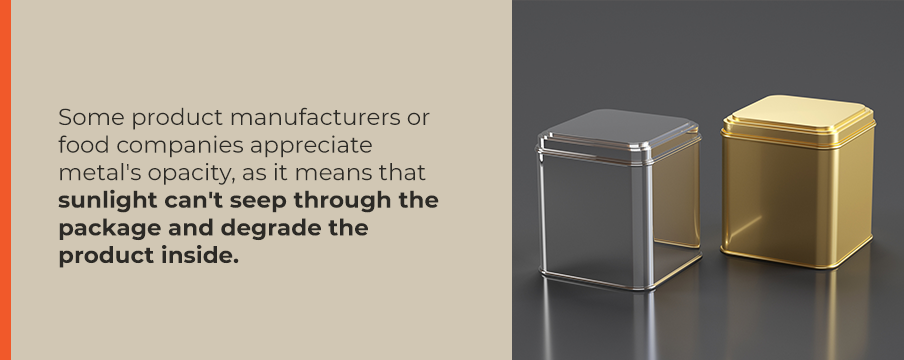How to Know If You Should Be Using Metal Packaging
By: phase1
Recently, more and more companies have begun packaging their goods in metal containers. Metal packaging not only looks good, but it can also do good.
Metals, such as aluminum and steel, are easy to recycle. Steel is the most recycled material on earth, and aluminum is one of the most valuable materials to recycle. About three-quarters of the aluminum produced in the U.S. remains in use today. Unlike other materials, such as plastics, you can recycle metals again and again, reducing the need to mine for more from the ground.
So, is metal the right choice for your company’s products? This guide will discuss the types of metal packaging, where it’s most often used and the benefits of switching to metal.
Where Metal Packaging Is Used
If you stroll down the aisles at a supermarket, big-box store or hardware store, you’ll see metal everywhere. Metal has a lot of uses, including:
- Aerosol cans: Products packaged in aerosol cans range from hairspray to cooking oil to spray paint to air fresheners. For an aerosol can to work, it needs to be airtight and leak-proof. Usually, aerosol cans are made from steel or aluminum. They also contain a propellant that pushes the product out of the can.
- Beverage cans: Soda, beer and even wine are often sold packaged in aluminum cans. Aluminum beverage cans are the most recycled category for aluminum products, with nearly 50 percent of all cans recycled annually.
- Canned foods: Vegetables, soups, fruits, pet food and meats are all often sold in metal cans. Canning foods helps prolong their shelf life and can help people afford to make healthy dietary choices.
- Paint cans: Although some types of paint are sold in plastic pails and containers, metal cans are still frequently used. Metal paint cans can be lined or unlined, depending on the type of paint.
- Lotion tubes: Lotions, toothpaste and other viscous beauty products can be packaged in metal tubes, rather than plastic tubes. Some consumers prefer metal tubes because they can be recycled and look better than plastic.
Types of Metal Packaging Materials
Several different types of metal can be used for packaging. Each type of material has its benefits and drawbacks. One metal might be more appropriate for certain applications compared to another metal, so it’s worth knowing the differences between each one:

Aluminum
People have been using aluminum to package foods and other products for well over 100 years. Some of the more popular uses of aluminum include cans and foil packaging. Some products have been packaged in aluminum for their entire existence. For example, the first rolls of Lifesavers were wrapped in aluminum foil in 1913. The candies are still sold in aluminum packaging today.
Besides Lifesavers candies, another popular use of aluminum is in the form of cans. Aluminum was first used as packaging for beer in 1959 when Coors began selling its product in cans. Half a century later, beverage companies are using aluminum cans to package everything from soda to craft beer to wine. More than 1,700 types of beers are sold in aluminum cans.
Some of the benefits of aluminum include its ability to resist rust and corrosion, its weight and its shelf life. Aluminum is also very easy to recycle. Most of the aluminum cans used today contain at least 70 percent recycled content.
Tin
Tin cans aren’t entirely made of tin. When tin is used in packaging, it’s actually applied as a thin layer on top of steel. One of the main benefits of tin-plating is that it helps to improve a package’s ability to resist corrosion.
Steel
Steel cans are often used for packaging canned foods, aerosol cans and paint cans. When steel is used for packaging foods, it is usually coated with a different metal, such as tin-plate, to enhance its ability to resist corrosion. Like aluminum, steel packaging is widely recycled and is easy to recycle. In 2017, more than six million tons of steel were recycled in the United States.
Steel without tin is one of the strongest packaging materials available. It’s often used to make large barrels or drums that hold items to be sold in bulk or for wholesale. Tin-free steel can also be used to make bottle caps.
Metal Packaging Advantages
Using metal for your products’ packaging offers many benefits to you, your customers and the product itself. Some of the benefits of using metal packaging include:
-
- Product protection: Some products need to be stored in dark packaging and kept away from sunlight or other sources of light. Whether you use aluminum or steel, the packages are opaque and keep sunlight from reaching the product inside. Metal packaging can also be airtight, keeping out oxygen that can cause a product to deteriorate.
- Durability: Some packaging materials break down over time. Paper, for example, will wear thin and is easily damaged by moisture. Plastics break down and become sticky as time goes on. Aluminum and steel are both considerably more durable than paper and plastic. Metal is made to last and to be used again and again. Coating the metal with a lining further enhances its durability.
- Sterility: It’s easy to sanitize and sterilize metal packaging. You can heat aluminum and steel to temperatures that are hot enough to kill bacteria and other germs. Metal is also non-porous, meaning there aren’t small crevices on its surface where germs can hide.
- Sustainability: Most types of metal are easily recycled. Aluminum and steel are two of the most recycled materials in the world, and rates of recycling are high for each one. Instead of having to extract new metal from the earth, most companies that use metal packaging use materials that are at least partially recycled.
- Size range: Another reason you might use metal packaging is that many different options are available to you. Metal packages come in a wide range of sizes and forms. Beverage cans can range in size from six to 20 ounces, for example. Metal cans used to package food can be eight ounces, 15.5-ounces or 28-ounces. Aerosol cans, paint cans and metal tubes are also available in a broad range of sizes.
- Affordability: Metal packaging tends to be relatively affordable for companies to use, thanks in part to its recyclability and the amount of metal available for use.
- Safety: Since metal is easily sterilized and non-porous, it is safe for use with food. There is a chance that certain types of metal can leach into certain types of products, such as aluminum leaching into acidic foods. But that can easily be prevented by lining the metal with a coating.
- Attractiveness: Metal packaging isn’t only practical. It can also look good. Beverage cans can be decorated with a brand’s logo and with multiple colors, making a product stand out on a shelf. Metal tubes used to package lotions or beauty products look shiny and visually appealing, compared to similar products packaged in plastic.
- Light weight: Some types of metal packaging, particularly aluminum, weigh a lot less than other materials. For example, a six-pack of 12-ounce aluminum beer cans weighs much less than a six-pack of 12-ounce glass beer bottles. The reduction in weight means lower shipping costs for your company, plus increased convenience for the people who buy your products.
- Small energy footprint: Metal’s recyclability, light weight and durability help to keep its energy footprint small. For example, the carbon dioxide footprint for transporting metal packaging is less than two percent of the total footprint.
- Storage capabilities: Packaging products in metal containers can extend their shelf life. Canned food, for example, can last for years longer than comparable fresh food products. Since you can usually stack metal cans and containers, it’s also easy to find storage space for your products when they are packaged in metal.
- Eco-consciousness: Many consumers are looking for ways to reduce their carbon footprint and to live more sustainable, eco-friendly lives. Since metal is widely known to be easy to recycle and known to have fewer risks to people and planet than plastic, using it to package your products can help you connect with consumers who want to go green.

Metal Packaging Disadvantages
Although metal packaging offers many advantages, it’s not the right choice for every type of product. There are some potential disadvantages to using metal that you’ll need to consider when designing your product packaging, including:
-
- Opacity: Some product manufacturers or food companies appreciate metal’s opacity, as it means that sunlight can’t seep through the package and degrade the product inside. On the other hand, there are times when people want the ability to see into a package. For example, a person might want to confirm that the contents of a bottle or bag are what they expect to purchase. Being able to see into a package helps a person confirm that they are buying the correct size, shape or color of an item.
- Corrosion and rust susceptibility: Another potential drawback of metal packaging is that corrosion is a possibility. Corrosion occurs when metal reacts with the environment surrounding it and begins to break down. If you’re concerned about packaging corrosion, you might want to choose a non-metal material or investigate using metals known for their corrosion-resistance. For example, aluminum has excellent corrosion resistance. Tin-plated stainless steel also has good corrosion resistance. How and where you store metal packaging can also influence whether it corrodes or rusts.
- Product reactions: Certain metals, such as aluminum, can react with the foods they come into contact with. Acidic foods, such as tomatoes, cause a reaction when they come into contact with aluminum. The metal can leach into the food, affecting its quality and taste. If you are packaging and selling products can that react with a type of metal, you might be better off choosing a different material. Additionally, a lining inside an aluminum can provides a barrier between the metal and the food, reducing the chance of a reaction.
- Weight: While certain types of metal, such as aluminum, are lighter in weight than some packaging materials, like glass, there are even lighter options available. If weight is an issue or if you want to reduce shipping costs significantly, you might decide to work with a very light material, such as cellophane or thin plastic.
- Rigidity: The stiffness and stability of metal packaging can be a drawback in certain cases. There’s no way to compact a metal container down to save space when storing it or to save space before filling the package. Paper packaging and packaging made of flexible plastic can often be folded or compacted, so it takes up less space.

The drawbacks of metal packaging might not be dealbreakers for you. You might find that trying out a different type of metal, such as using aluminum instead of steel or vice versa, allows you to design a package that’s attractive, cost-effective and environmentally-conscious. On the other hand, you might find that another material, whether it’s plastic, paper or cellophane, provides better results for you.
Let Phase 1 Prototypes Build Your Packaging Prototypes
If you want packaging that’s durable, recyclable and affordable, metal might be the way to go. It can be helpful to review each type of material available for use before you make your choice, though.
You get one chance to make an excellent first impression on a customer, and the packaging you use plays a big role in that. Your product’s packaging should reassure the customer that the item inside is high-quality and worth their hard-earned money. After designing your packaging, the next step is to order a prototype, so you can see the packaging in three dimensions and up close.

Phase 1 Prototypes can turn your packaging design and vision into a physical prototype. We offer custom solutions and work quickly, delivering quotes within 24 hours or less. We work with a variety of materials and offer numerous packaging options, from foil to shrink wrap to boxes to bags. If you have a design and are ready to see how it will look in real life, contact us for a quote today.

Leave a Reply